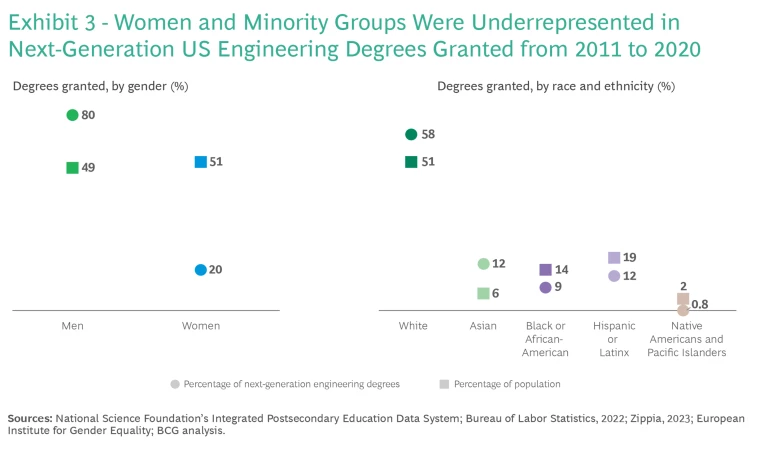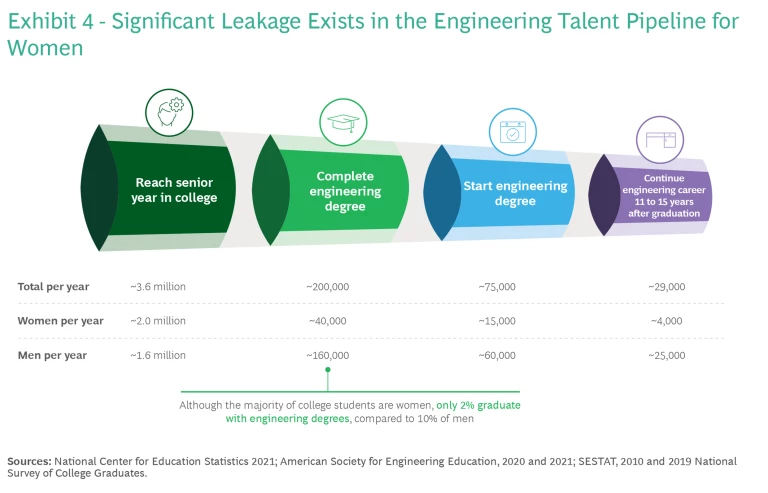This content was developed in partnership with SAE International.
Every year, the US will need about 400,000 new engineers. Yet the next-generation skill sets that those engineers will require are sorely lacking, presenting the alarming possibility that nearly one in three engineering roles will remain unfilled each year through at least 2030. This persistent talent gap risks short-circuiting the progress of several essential industries. It may also seriously inhibit various US government initiatives intended to boost the economy and US competitiveness, such as the 2022 Build Back Better Act (BBBA) and the 2022 Chips and Science Act.
Efforts to bridge the gap today face a number of hurdles, including a struggle to increase diversity and inclusion, insufficient reskilling and upskilling efforts, and limited coordination—both across industries and between industries and educational institutions. In this paper, written by BCG in collaboration with SAE International , we propose a coordinated, multipronged, and sustainable response that involves both public- and private-sector players.
A Core Driver of GDP Impact and Economic Risk
A recent BCG survey revealed that an overwhelming 92% of leaders of global companies rank attracting and retaining talent among their top three priorities. Engineering talent in particular is in short supply, with a growing gap between supply and demand that puts the progress of important industries at risk and threatens to have a tremendous negative impact on the economy—equal to nearly 40% of the projected GDP impact of all talent gaps expected in the US through 2030. (See Exhibit 1.)

Our analysis of Bureau of Labor Statistics (BLS) data indicates that demand for engineering skills will grow by about 13% from 2023 to 2031. And the American Council of Engineering Companies, which represents nearly 6,000 firms, has issued a letter to President Biden stating that a talent scarcity in the engineering and design services industry is already impeding important work for the BBBA.
The US is not the only country facing an engineering talent shortage. For example, the Japanese Ministry of Economy has predicted a deficit of over 700,000 engineers in Japan by 2030, and the German Economic Institute reported a shortage of 320,000 STEM specialists in Germany as of April 2022.
In light of these global challenges and the US’s longstanding cap on H-1B visas, which limits the immigration of foreign engineering and other specialized talent to 85,000 people per year, recruitment from other countries is likely to fill only a modest portion of the anticipated annual gap. Consequently, the US public and private sectors must address the shortfall through domestic talent-supply pipelines.
Key Challenges to Bridging the Gap
Together with SAE International, we have identified several challenges that hinder US efforts to address and close the engineering gap, from a lack of the most in-demand skills to limited diversity at every stage of the engineering journey.
Mismatch Between Available and In-Demand Skills. Although the overall gap between new engineering roles created and new engineers entering the market each year is already stark, at about 133,000, the underlying data presents an even more problematic picture. Much of the engineering gap expected in the US over the next ten years will involve unfilled positions in software, industrial, civil, and electrical engineering, amounting to a staggering 186,000 job vacancies across the US by 2031. At the same time, we project that other engineering roles, in areas such as materials, chemical, aerospace, and mechanical engineering—which have traditionally been popular choices for undergraduate study—will see an oversupply of 41,000 qualified candidates by the same year. (See Exhibit 2.) What’s more, the skills required to deliver all of these roles are dynamic, not static. Even conventional engineering roles will increasingly require a fusion of hard and soft skills, with T-shaped skill profiles that include both deep knowledge in a specific area and cross-disciplinary expertise. And engineering roles will come with a baseline expectation that workers be familiar with next-generation techniques—those that are forecast to see the highest growth in demand over the next five years, such as agile methodology, new product development, and test-driven development.

Rapid growth in generative AI (GenAI) capabilities will cause further skill disruptions. Although it will reduce some talent requirements, GenAI will also create new needs for engineers who can understand and interact with the technology. These budding requirements will add to the skills gap and further affect workforce planning.
A Struggle for Diversity and Inclusion. The engineering field has long struggled to broaden its diversity and inclusiveness. Despite significant investment and numerous programs aimed at reducing the gender gap in engineering, just 16% of US engineers are women, according to an analysis of 2022 BLS data. And the proportion of women among US college graduates in engineering fields has stagnated at around 20%, with a nearly flat CAGR in the decade from 2012 to 2022. In addition, our analysis reveals that Black Americans, Latinxs, Native Americans, and Pacific Islanders are also underrepresented relative to their incidence in the population. (See Exhibit 3.) Yet increasing diversity has multiple benefits, including improving the quality of work output and innovation and enlarging the supply of available talent.

Insufficient Reskilling and Upskilling. The size of the engineering gap and the degree of the skills shift have implications for how to address the shortages. Although employers often seek to “buy” their way out of talent shortages through new hires, many are increasingly resorting to borrowing or building scarce talent by engaging highly skilled gig workers and upskilling current employees, among other measures. For next-generation engineering skills in particular, there simply are not enough potential hires in the market for companies to buy their way out of the shortage. Organizations must upskill their current employees (by moving them from more junior roles into more senior ones), reskill them (by cross-training them from engineering roles that are less in demand), or hire a partial fit and upskill the last 10% to 20% of capabilities.
Although CEOs recognize the need to train their employee base, our research indicates that many struggle to develop robust learning and development (L&D) ecosystems and have mixed confidence in their HR teams’ ability to deliver impact. And this struggle trickles down: according to Harvard Business Review, 75% of approximately 1,500 managers surveyed across organizations say they are dissatisfied with their company’s L&D. Engineering-heavy industries such as industrial goods are particularly underdeveloped, with about 10% to 20% fewer L&D hours per worker, on average, than other industries provide, making this an increasingly urgent issue.
Major Leaks in the Pipeline. A leaky talent pipeline exacerbates the engineering gap, especially with regard to diversity and the lead time required to develop talent from early education onward. Of the total number of students who express an interest in engineering while still in high school, only about 13% complete a university degree in engineering, according to BCG analysis. Several organizations (including SAE International, SAE Foundation, and the Society of Women Engineers) have shown that encouraging and maintaining STEM interest throughout a child’s education, especially at the middle-school level, is critical to helping fill the talent gap; and conversely, if interest wanes during this period, there is a lower probability that the student will pursue an engineering degree.
Our own research, which focuses further along the pipeline, reveals additional challenges in converting engineering students to practitioners. (See Exhibit 4.) Fewer than half of the approximately 200,000 US students who complete engineering degrees in the fields we analyzed go on to pursue an engineering role. According to American Society for Engineering Education, only 37% of students begin an engineering career after completing an engineering degree. Moreover, although women make up the majority of college students, only 2% of women graduate with an engineering degree, compared to 10% of men. Doubling the number of women who pursue engineering degrees could contribute up to 40,000 more engineers annually and reduce the US engineering gap by 30%, assuming a 100% conversion rate to engineering careers.

Persistence in engineering careers is uneven, too, according to a 2022 survey of college graduates by the National Center for Science and Engineering Statistics. Although male and female engineering graduates start their careers with similar retention rates, the retention rates for women drop drastically below those for men over time. As an example, only 27% of women who completed engineering degrees from 2006 to 2010 were still working in engineering jobs in 2021, compared to 41% of their male counterparts.
Misaligned Incentives Across Stakeholders. Another roadblock to progress involves structural disconnects between public and private sector stakeholders that subvert collaboration. Companies find themselves competing for talent from the same limited pool and so may be reluctant to join sector-wide upskilling or marketing efforts out of concern that their investments will benefit competitors. Meanwhile, educational institutions and employers operate on radically different timelines—with institutions educating the next generation even as employers seek ready-to-deploy talent today. The two may also have different views about whether professors or future employers should have the final say on what students should learn.
Although public and private educational institutions are well intentioned and aspire to solve the problem, these structural misalignments can lead to friction in collaborative initiatives that they undertake with companies and industry organizations, often resulting in one-off approaches and subscale or redundant efforts that fail to achieve meaningful change.
Tackling the Challenges
We recognize that ample efforts to mitigate the looming engineering gap already exist. Current programs range in size and scale, with involvement across the private, public, and not-for-profit sectors, and have shown positive results. Ultimately, however, narrowing the gap will require major stakeholders—employers, educators, and the government—to come together in new ways to scale current efforts that deliver positive results and to deploy a range of new initiatives, from increasing female representation to reskilling the current workforce, testing these initiatives and learning as they go.
The solution requires strong coordination. It will therefore entail identifying a core orchestrator—a central figure or organization to assume responsibility for choreographing the collaborative efforts of all stakeholders and ensuring that they are in agreement.
As an example, one public-private partnership agency dedicated to job creation, growth, and economic development in a Southeast Asian country embraced the role of core orchestrator by collaborating closely with industries, education providers, and other stakeholders across the country. Through benchmarking, stakeholder input, and research, it launched a first-of-its-kind talent program that forecasted job titles and gaps for the next five years, engaged education providers to develop tailored training programs, and initiated recruiting efforts to build a talent pipeline for current and future roles.
Although various efforts to create a cooperative organization and designate a core orchestrator continue, we propose several practical steps that individual companies can take to build on prior achievements and work toward closing the talent gap.
Plan the workforce strategically. Companies should allocate resources to initiatives that have the greatest potential to create significant positive outcomes, such as efforts to improve diversity or boost the general understanding of future needs. Strategic workforce planning, for one, is crucial if organizations are to successfully navigate a changing environment and fill the myriad new roles that will emerge in the coming years. By proactively analyzing and forecasting their workforce requirements, companies can make informed decisions about talent acquisition, development, and retention, and ensure that they have the right people in the right roles at the right time.
One major online retailer faced challenges in sourcing technically qualified candidates and struggled internally to understand its true talent needs. In response, it mapped 20,000 vacant internal technical job roles in emerging fields such as cloud computing and machine learning, and then implemented initiatives such as machine learning universities, apprenticeships, prepaid tuition programs, and intensive IT training for its nontechnical workers. The retailer now aims to train a total of 100,000 employees at a cost of $700 million by 2025, growing a skilled workforce to bridge the talent gap.
Create a common taxonomy. Businesses need to collaborate industry-wide on creating a common taxonomy to reduce confusion and support effective forecasting. With a common taxonomy, businesses could explore nonconventional hiring routes, such as partnering with community colleges, to increase the talent pool. This approach would ensure that potential employees already possess the skills they require and would allow companies to focus on further training and development. In the absence of this collaborative effort, inconsistent identification and categorization of skills could restrict the potential benefits of industry-school partnerships.
For example, a public-private partnership agency that was focused on job creation and economic growth embarked on a journey to address talent development challenges in one US state. Initially, the agency sought to discern the most crucial initiatives for significantly improving the state's workforce skills. With a comprehensive approach that included benchmarking, stakeholder input, and extensive research, it identified high-impact talent initiatives in line with the state's priorities. Then it launched a pioneering talent program in close collaboration with industry, educational institutions, and other stakeholders. This program addressed the most pressing employer needs and constructed a common taxonomy for engineering skills, using data from The Burning Glass Institute and employer interviews. The new taxonomy helped in forecasting required job titles, identifying skill gaps, and engaging with education providers to create tailored learning modules that supported efforts to train the talent needed to fill the gap.
Retrain existing employees. In designing and implementing talent initiatives, companies should focus on ensuring that they have a lasting impact on the talent pool. Faced with a projected oversupply of 41,000 engineers in legacy skilled fields by 2031, for example, companies should shift some of their focus away from hiring to reskilling or upskilling, moving their employees away from older engineering skills and toward newer skills through the use of intensive training programs. Such retraining reflects awareness of the long-term benefits and cost effectiveness of investing in a company’s current workforce. Notably, the Financial Services Skills Commission estimates that the cost of hiring a new employee is about 2.5 times as high as the cost of retraining an existing employee.
One global consumer durables company successfully implemented an experiential learning program to help employees develop critical new business skills in performance marketing and data analytics and apply those capabilities to projects in key business areas. The company taught program participants concepts and helped them develop proficiency through application of those concepts to real-life projects. Finally, it embedded and engaged the employees’ new knowledge by making it a part of their day-to-day jobs. In the pilot year, the program certified nearly 50 employees; the company is now scaling it to certify many more in the future.
Collaborate. Forming partnerships between companies and educational institutions , including universities and community colleges—and even involving the public sector—has great potential. Such collaborations can enhance communications and transparency with regard to the talent demands of various industries—for example, to more closely connect educational offerings and workforce needs.
With state support, one leading global aerospace company collaborated with regional high schools to develop a two-year advanced manufacturing curriculum to prepare students for high-demand jobs through hands-on learning. The program currently serves more than 50 high schools and 3,000 students, and the company is now hiring most of the program’s graduates.
In another example, a prominent global technology leader has initiated an AI workforce program that offers 225 hours of AI course content, faculty training, and implementation guidance to community colleges across the US, with the goal of expanding AI education to all 50 states by 2023. Currently, 31 schools in 18 states have joined the program, which prepares students for various AI-related roles. Through its partnerships with the colleges, the company has also created new job categories, such as AI engineering technician. This innovative initiative recognizes that not all AI skills require traditional bachelor's degrees and encourages students interested in these roles to pursue community college degrees. As the program’s outcomes unfold, the company is actively monitoring student achievement, fostering collaboration with employers, and supporting underrepresented student populations in AI roles. This forward-thinking approach aims to address labor market needs while promoting diversity and inclusion in the emerging tech-driven job market.
A similar collaboration between engineering schools and the automotive industry could help close the engineering gap in that sector. As production of internal combustion engine vehicles declines, demand for mechanical engineers who specialize in this area is likely to fall. Through open dialogue, automotive companies could present their changing priorities and talent requirements to schools, helping the latter to adjust their programs and equip students with skills that are more urgently needed in emerging areas of the industry, such as in electric vehicles or autonomous driving technologies.
Addressing the talent gap in engineering is a complex challenge that requires a sustained, coordinated, multipronged approach that involves both public and private sector players. By focusing on developing future engineers from an early stage and working together to address systemic issues, stakeholders can strengthen the talent pipeline and ensure a continuous and sustainable supply of skilled professionals for decades to come.
The author team deeply appreciates the invaluable contributions of their partners at SAE International, Sri Srinath, Dan Nicholson, Jamie Ferguson, and Joan Wills. Dan, Jamie, and Joan are also trustees of the SAE Foundation, SAE International’s charitable arm.
About SAE International
SAE International and BCG are working together to help identify a core orchestrator and create a platform to advance potential initiatives. We welcome like-minded individuals and organizations that care about this effort to join our coalition. To be a part of the solution or follow our progress, please reach out to the authors of this publication.











